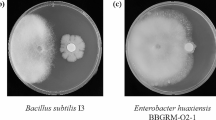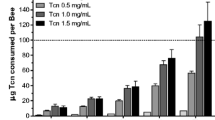Abstract
Many species of insects are known to produce and secrete benzoquinone derivatives. These compounds are usually defined as “defense chemicals.” However, in many cases, it has not been determined what the chemicals are meant to defend against. Tribolium beetles produce up to three benzoquinones, but their specific function is not known. In this experiment, one of the derivatives, methyl-1,4-benzoquinone (MBQ) was tested for its effectiveness for one of its purported functions as an antimicrobial. Methyl-1,4-benzoquinone was added in three concentrations (0.3, 30, and 150 μg/ml) to the liquid media of three species of Bacillus bacteria and eight species from four genera of yeasts, and the effect on their growth was monitored. The presence of MBQ altered growth in all species. The bacteria responded more negatively than the yeasts. All bacteria species showed reduced growth at all levels of MBQ. Yeasts were more tolerant to the presence of the chemical, and two species, Saccharomyces microellipsoides and Pichia burtonii, actually showed increased growth at the lowest level of MBQ.



Similar content being viewed by others
References
Abdel-Razek, A. S. 2002. Comparative study on the effect of two Bacillus thuringiensis strains of the same serotype on three coleopteran pests of stored wheat. J. Egypt. Soc. Parasitol. 32:415–424.
Abdel-Razek, A. S., Salama, H. S., White, N. D. G., and Morris, O. N. 1999. Effect of Bacillus thuringiensis on feeding and energy use by Plodia interpunctella (Lepidoptera: Pyralidae) and Tribolium castaneum (Coleoptera: Tenebrionidae). Can. Entomol. 131:433–440.
Blum, M. S. 1981. Chemical Defenses of Arthropods. Academic Press, New York.
Bouchard, P., Hsiung, C. C., and Yaylayan, V. A. 1997. Chemical analysis of defense secretions of Siploidea sipylus and their potential use as repellents against rats. J. Chem. Ecol. 23:2049–2057.
Chapman, R. N. 1926. Inhibiting the process of metamorphosis in the confused flour beetle (Tribolium confusum Duval). J. Exp. Zool. 45:293–299.
Charbonneau, R., and Lemonde, A. 1962. Indeterminate growth factors in brewer’s yeast. IV. Relation between these factors and the nitrogen levels in the diet of Tribolium confusum Duval larvae. Arch. Int. Physiol. Biochim. 70:379–392.
Dettner, K. 1993. Dabbing and shooting of benzo- and napthoquinone secretions: defensive strategies of bark-inhabiting Aleocharine (Col.: Staphylinidae) and Tenebrionid (Col.: Tenebrionidae) beetle larvae. J. Chem. Ecol. 19:1337–1354.
Dunkel, F. V. 1988. The relationship of insects to the deterioration of stored grain by fungi. Int. J. Food Microbiol. 7:227–244.
El-Mofty, M. M., Khudoley, V. V., Sakr, S. A., and Fathala, N. G. 1992. Flour infested with Tribolium castaneum, biscuits made of this flour, and 1,4-benzoquinone induce neoplastic lesions in Swiss Albino mice. Nutr. Cancer 17:97–104.
Engelhardt, M., Rapoport, H., and Sokoloff, A. 1965. Odorous secretion of normal and mutant Tribolium confusum. Science 150:632–633.
Farmiloe, F. J., Concord, S. J., Coppock, J. B. M., and Ingram, M. 1954. The survival of Bacillus subtilis spores in the making of bread. J. Sci. Food Agric. 5:292–304.
Faust, R. M. 1974. Bacterial diseases, pp. 87–183, in G. E. Cantwell (ed.). Insect Diseases. Marcel Dekker, New York.
Geiger, W. B. 1946. The mechanism of the antibacterial action of quinones and hydroquinones. Arch. Biochem. 11:23–32.
Happ, G. M. 1968. Quinone and hydrocarbon production in the defensive glands of Eleodes longicollis and Tribolium castaneum (Coleoptera, Tenebriondae). J. Insect Physiol. 14:1821–1837.
Kreig, A. 1981. The genus Bacillus: insect pathogens, in M. P. Starr, H. Stolp, H. G. Truper, A. Balows, and H. G. Schlegel (eds.). The Prokaryotes: A Handbook on Habitats, Isolation, and Identification of Bacteria. Springer-Verlag, Berlin.
Kumari, S. M., and Neelgund, Y. F. 1985. Preliminary infectivity tests using six bacterial formulations against the red flour beetle, Tribolium castaneum. J. Invertebr. Pathol. 46:198–1999.
Kurtzman, C. P., Wickerham, L. J., and Hesseltine, C. W. 1970. Yeasts from wheat and flour. Mycologia 62:542–547.
Norris, J. R., Berkeley, R. C. W., Logan, N. A., and O’donnell, A. G. 1981. The genera Bacillus and Sporolactobacillus, pp. 1709–1742, in M. P. Starr, H. Stolp, H. G. Truper, A. Balows, and H. G. Schlegel (eds.). The Prokaryotes: A Handbook on Habitats, Isolation, and Identification of Bacteria. Springer-Verlag, Berlin.
Offhaus, K. 1952. Vitamin requirements of the confused flour beetle (Tribolium confusum Duval). I. The water-insoluble yeast fraction required by Tribolium confusum. Z. Vitam. Horm. Fermentforsch. 4:555–563.
Okagbue, R. N. 1990. Identification of yeasts and aerobic spore forming bacteria from cassava flour. Food Microbiol. 7:27–32.
Pappas, P. W., and Morrison, S. E. 1995. Benzoquinones of the beetles, Tribolium castaneum and Tribolium confusum. Prep. Biochem. 25:155–168.
Pappas, P. W., and Wardrop, S. M. 1996. Quantification of benzoquinones in the flour beetles, Tribolium castaneum and Tribolium confusum. Prep. Biochem. Biotechnol. 26:53–66.
Prendeville, H. R., and Stevens, L. 2002. Microbe inhibition by Tribolium flour beetles varies with beetle species, strain, sex, and microbe group. J. Chem. Ecol. 28:1183–1190.
Richter, K. S., Dorneanu, E., Eskridge, K. M., and Rao, C. S. 1993. Microbiological quality of flours. Cereal Foods World 38:367–369.
Rogers, R. F. 1978. Bacillus isolates from refrigerated doughs, wheat flour, and wheat. Cereal Chem. 55:671–674.
Roth, L. M., and Howland, R. 1941. Studies on the gaseous secretion of Tribolium confusum Duval. I. Abnormalities produced in Tribolium confusum Duval by exposure to a secretion given off by the adults. Ann. Entomol. Soc. Am. 34:151–171.
Sall, J., Creighton, L., and Lehman, A. 2006. JMP Start Statistics. Thomson Learning, Cary
Sorokulova, I. B., Reva, O. N., Smirnov, V. V., Pinchuk, I. V., Lapa, S. V., and Urdaci, M. C. 2003. Genetic diversity and involvement in bread spoilage of Bacillus strains isolated from flour and ropy bread. Lett. Appl. Microbiol. 37:169–173.
Via, S., and Conner, J. 1995. Evolution in heterogeneous environments: genetic variability within and across different grains in Tribolium castaneum. Heredity 74:80–90.
Weatherston, J. 1967. The chemistry of arthropod defense substances. Q. Rev. Chem. Soc. Lond. 21:287–313.
Williams, G. C. 1966. Adaptation and Natural Selection. Princeton University Press, Princeton.
Yamada, Y., and Hosaka, K. 1977. A convenient synthesis of alkyl-substituted p-benzoquinones from p-alkylphenols. Synthesis 143:53–54.
Yezerski, A., Gilmor, T. P., and Stevens, L. 2000. Variation in the production and distribution of substituted benzoquinone compounds among genetic strains of the confused flour beetle, Tribolium confusum. Physiol. Biochem. Zool. 73:192–199.
Yezerski, A., Gilmor, T. P., and Stevens, L. 2004. Genetic analysis of benzoquinone production in Tribolium confusum. J. Chem. Ecol. 30:1034–1044.
Yezerski, A., Cussatt, G., Glick, D. L., and Evancho, M. 2005. The effects of the presence of stored product pests on the microfauna of a flour community. J. Appl. Microbiol. 98:507–515.
Author information
Authors and Affiliations
Corresponding author
Rights and permissions
About this article
Cite this article
Yezerski, A., Ciccone, C., Rozitski, J. et al. The Effects of a Naturally Produced Benzoquinone on Microbes Common to Flour. J Chem Ecol 33, 1217–1225 (2007). https://doi.org/10.1007/s10886-007-9293-2
Received:
Revised:
Accepted:
Published:
Issue Date:
DOI: https://doi.org/10.1007/s10886-007-9293-2




